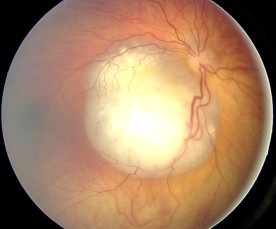 |
| Maternal and paternal age didn't appear to influence bilateral retinoblastoma risk in this study. Photo: Isabelle Aerts/wikicommons. Click image to enlarge. |
Older maternal and paternal age has been associated with various congenital conditions, including Down syndrome and several cancers. Retinoblastoma results from either a somatic or a germline pathogenic variant in the RB1 tumor suppressor gene, causing inactivation. While both older maternal age and decreasing birth order are known to increase the risk of de novo germline pathogenic variants, researchers did not find any associations between these factors or GDP per capita and the ratio of bilateral to unilateral retinoblastoma cases.
The study analyzed data from 688 patients from 11 retinoblastoma treatment centers in 10 countries from five continents. Cases were classed as bilateral if they were bilateral at initial presentation or if they originally presented unilaterally and subsequently developed a bilateral phenotype. Of those patients, 33.1% possessed bilateral retinoblastoma. There was no significant difference in maternal age between the bilateral retinoblastoma group and the unilateral retinoblastoma group. Univariate analysis revealed that the distributions of birth order for bilateral vs. unilateral retinoblastoma also did not differ significantly. GDP per capita was evaluated as it allowed the researchers to assign each country a continuous variable that was incorporated into a regression model; there was no significant difference between the groups, both with non-parametric (Chi-square) and parametric statistics (logistic regression model).
“These factors do not contribute to the development of a de novo germline pathogenic variant in RB1,” the researchers concluded. “However, this study did not use genetic testing, so we could only use laterality data as an indication of origin of the pathogenic variant, i.e., inherited, somatic or de novo.”
They believe that larger studies assessing genetic testing of patients and healthy controls should be used to reach an unequivocal conclusion. “Although any factor causing an increased risk of developing a de novo germline pathogenic variant in RB1 should cause an increase in the number of bilateral retinoblastoma patients, one cannot be certain that the increase is not due to a change in the small proportion of the patients with somatic pathogenic variants in RB1 within the group,” they wrote in their paper.
Lloyd P, Westcott M, Kaliki S, et al. The role of maternal age & birth order on the development of unilateral and bilateral retinoblastoma: a multicenter study. Eye (Lond). March 31, 2022. [Epub ahead of print]. |

